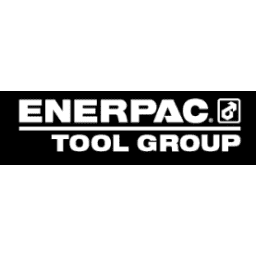
Enerpac Tool Group Corp
NYSE:EPAC


| US |

|
Johnson & Johnson
NYSE:JNJ
|
Pharmaceuticals
|
| US |

|
Berkshire Hathaway Inc
NYSE:BRK.A
|
Financial Services
|
| US |

|
Bank of America Corp
NYSE:BAC
|
Banking
|
| US |

|
Mastercard Inc
NYSE:MA
|
Technology
|
| US |

|
UnitedHealth Group Inc
NYSE:UNH
|
Health Care
|
| US |

|
Exxon Mobil Corp
NYSE:XOM
|
Energy
|
| US |

|
Pfizer Inc
NYSE:PFE
|
Pharmaceuticals
|
| US |

|
Palantir Technologies Inc
NYSE:PLTR
|
Technology
|
| US |

|
Nike Inc
NYSE:NKE
|
Textiles, Apparel & Luxury Goods
|
| US |

|
Visa Inc
NYSE:V
|
Technology
|
| CN |

|
Alibaba Group Holding Ltd
NYSE:BABA
|
Retail
|
| US |

|
3M Co
NYSE:MMM
|
Industrial Conglomerates
|
| US |

|
JPMorgan Chase & Co
NYSE:JPM
|
Banking
|
| US |

|
Coca-Cola Co
NYSE:KO
|
Beverages
|
| US |

|
Walmart Inc
NYSE:WMT
|
Retail
|
| US |

|
Verizon Communications Inc
NYSE:VZ
|
Telecommunication
|
Utilize notes to systematically review your investment decisions. By reflecting on past outcomes, you can discern effective strategies and identify those that underperformed. This continuous feedback loop enables you to adapt and refine your approach, optimizing for future success.
Each note serves as a learning point, offering insights into your decision-making processes. Over time, you'll accumulate a personalized database of knowledge, enhancing your ability to make informed decisions quickly and effectively.
With a comprehensive record of your investment history at your fingertips, you can compare current opportunities against past experiences. This not only bolsters your confidence but also ensures that each decision is grounded in a well-documented rationale.
Do you really want to delete this note?
This action cannot be undone.

| 52 Week Range |
28.71
51.57
|
| Price Target |
|
We'll email you a reminder when the closing price reaches USD.
Choose the stock you wish to monitor with a price alert.

|
Johnson & Johnson
NYSE:JNJ
|
US |

|
Berkshire Hathaway Inc
NYSE:BRK.A
|
US |

|
Bank of America Corp
NYSE:BAC
|
US |

|
Mastercard Inc
NYSE:MA
|
US |

|
UnitedHealth Group Inc
NYSE:UNH
|
US |

|
Exxon Mobil Corp
NYSE:XOM
|
US |

|
Pfizer Inc
NYSE:PFE
|
US |

|
Palantir Technologies Inc
NYSE:PLTR
|
US |

|
Nike Inc
NYSE:NKE
|
US |

|
Visa Inc
NYSE:V
|
US |

|
Alibaba Group Holding Ltd
NYSE:BABA
|
CN |

|
3M Co
NYSE:MMM
|
US |

|
JPMorgan Chase & Co
NYSE:JPM
|
US |

|
Coca-Cola Co
NYSE:KO
|
US |

|
Walmart Inc
NYSE:WMT
|
US |

|
Verizon Communications Inc
NYSE:VZ
|
US |
This alert will be permanently deleted.
 Enerpac Tool Group Corp
Enerpac Tool Group Corp
Enerpac Tool Group Corp
Investor Relations
Enerpac Tool Group Corp., an industrial tools and services behemoth, originates from a legacy embedded in precision and performance. The company, rooted in muscle and mechanics, specializes in high-force hydraulic tools, torque wrenches, heavy lifting equipment, and solutions that serve a myriad of industries including oil & gas, aerospace, and mining. Their product range isn’t just about raw force; it's an epitome of engineering finesse, providing specialized equipment that performs in the pressure-cooker environments of major industrial operations. The sophistication of Enerpac’s offerings lies in their design to perform indispensable roles in lifting, bending, and maneuvering applications where precision and reliability can't be compromised.
The heartbeat of Enerpac's business model is their expansive service and product portfolio that caters to both routine maintenance and complex, customized operation solutions. Revenue flows from not just the sale of cutting-edge tools but also from providing indispensable support services, including safety training, system diagnosis, and maintenance, which are crucial for their clients who demand zero downtime in operations. By ensuring their products perform in challenging conditions, Enerpac cultivates a brand reputation grounded in reliability, thereby fostering enduring client relationships. Through continual innovation in both products and service solutions, the company manages to uphold not just its legacy but also its financial health, sustaining its growth engine in an ever-demanding industrial market landscape.

Enerpac Tool Group Corp., an industrial tools and services behemoth, originates from a legacy embedded in precision and performance. The company, rooted in muscle and mechanics, specializes in high-force hydraulic tools, torque wrenches, heavy lifting equipment, and solutions that serve a myriad of industries including oil & gas, aerospace, and mining. Their product range isn’t just about raw force; it's an epitome of engineering finesse, providing specialized equipment that performs in the pressure-cooker environments of major industrial operations. The sophistication of Enerpac’s offerings lies in their design to perform indispensable roles in lifting, bending, and maneuvering applications where precision and reliability can't be compromised.
The heartbeat of Enerpac's business model is their expansive service and product portfolio that caters to both routine maintenance and complex, customized operation solutions. Revenue flows from not just the sale of cutting-edge tools but also from providing indispensable support services, including safety training, system diagnosis, and maintenance, which are crucial for their clients who demand zero downtime in operations. By ensuring their products perform in challenging conditions, Enerpac cultivates a brand reputation grounded in reliability, thereby fostering enduring client relationships. Through continual innovation in both products and service solutions, the company manages to uphold not just its legacy but also its financial health, sustaining its growth engine in an ever-demanding industrial market landscape.





























 You don't have any saved screeners yet
You don't have any saved screeners yet
